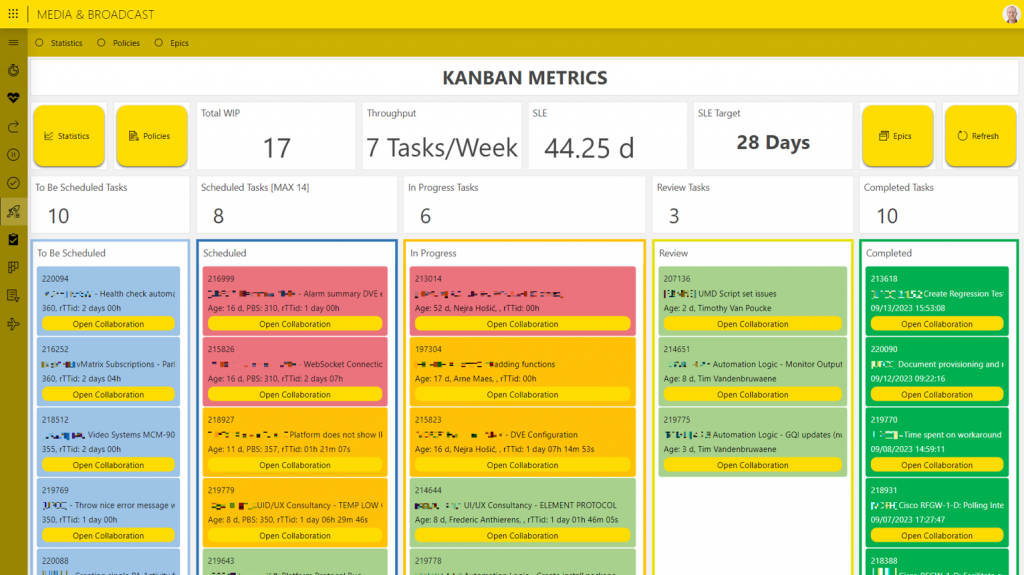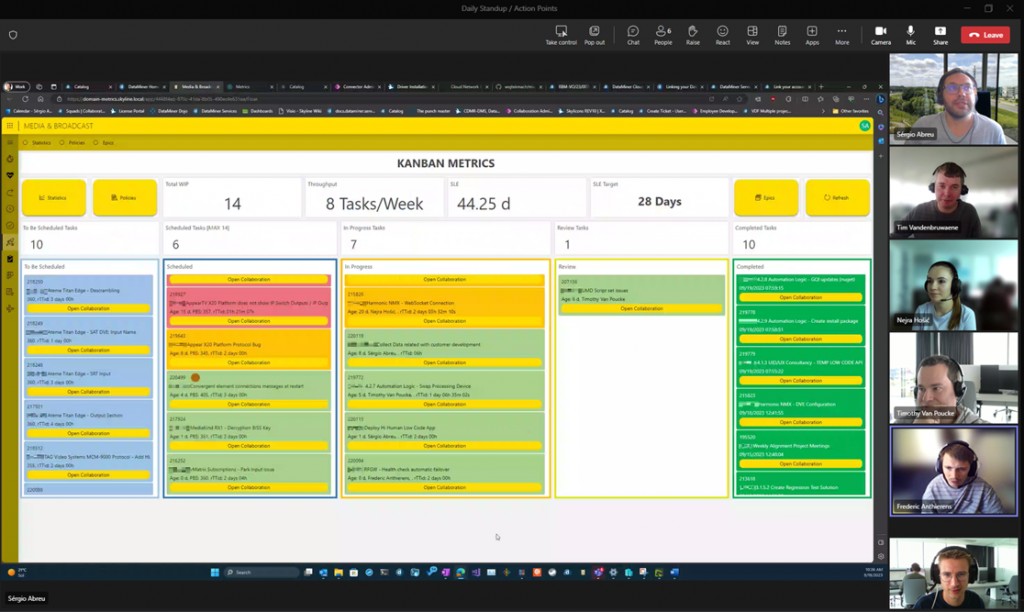The transitions we’re experiencing today are fundamentally different in nature to anything we have experienced before. Digital Transformation is inevitable, and that is why DataMiner, as a transformational platform, serves as the core operational platform for many leading companies.
Unfortunately, merely installing the latest generation of technology and hoping this will automatically launch you into the new era is no longer sufficient. How you use transformational technology to empower your organization is equally important.
Today’s new enabling technologies are reshaping the business landscape as we know it, including everything we are accustomed to. That is why our strategic goals now encompass building an agile operation that is ready to tackle the unexpected and able to adapt and evolve quickly.
In this post, we’ll explore how one of Skyline Communications’ squads, named Fiber, faces the unknown and masterfully manages and enhances its value flow. While each team is unique, you’ll discover numerous practices that can be tailored to fit your needs.
The Fiber squad: How do they optimize their value flow?
We believe that reliable access to information is a basic right for everyone. Information is the fuel that changes the world and liberates people. It has the power to emancipate and to inspire. We believe that people around the globe should have free and equal access to ICT media and broadband services.
The Fiber Squad
Who are we: the fiber of the Media & Broadcast industry

This is the Fiber squad! We’ll be taking a look at how this team operates, how they manage to work together as a force to be reckoned with, and how they are not a feature factory but something better. The Fiber squad works together to deliver value!
Optimizing value flow with Kanban
The Fiber squad has embarked on a deliberate journey with Kanban to enhance the efficiency and effectiveness of their value delivery process. With a focus on transparency, flexibility, and continuous improvement, Kanban offers the squad a way to visualize their workflow, monitor work item age, identify bottlenecks, and make data-driven decisions.
By embracing this system, the team aims to streamline their processes, exert control over the work in progress, and, most importantly, consistently and predictably deliver value to stakeholders, all while fostering a culture of collaboration and adaptability within the organization.
Kanban essentials
Kanban is renowned for its simplicity, requiring only a few essentials to get started. There’s no need for new roles, additional meetings, or changes in job titles. Instead, you can seamlessly integrate Kanban into your existing processes.
So, what are Kanban’s core elements?
- Visualization of workflow: a clear depiction of your process
- Four key metrics:
- Work in Progress (WIP)
- Throughput
- Work Item Age
- Cycle Time
- Definition of workflow: understanding and outlining your process
- Commitment to value optimization: always striving for the best outcomes
While these fundamentals remain consistent across all Kanban teams, their practical implementation can vary significantly. Each team, with its unique composition and environment, will have distinct workflow definitions and visualizations.
Kanban in action: the Fiber approach
The final above-mentioned core element, committing to value optimization, entails that the information you’re about to read may already be evolving. And that’s a positive sign! Fiber’s commitment to maximizing value leads to continuous adaptations—retaining what proves effective and refining or eliminating what doesn’t contribute to their quest for optimization.
Visualization of the Fiber workflow

The Fiber team has everything at their fingertips to optimize the value they produce, making use of an always up-to-date low-code app.
We ♥️ DataMiner, so it was only natural to develop a connector that extracts task data from Project Collaboration. Using the low-code app, the Fiber team has tailored both the data and user experience to their exact preferences. They continue to refine it weekly, finding new ways for the tool to serve them better.
Considering crafting a connector yourself to extract data from platforms like Jira, Azure DevOps, or other boards?
The four key metrics
- Work in Progress (WIP): Monitor the number of ongoing tasks to avoid overburdening the team.
- In the Fiber app, the Work in Progress metric is displayed as a “Total WIP” pane, which indicates the total number of tasks currently in progress.
- Throughput: Gauge the number of tasks completed within a set timeframe.
- In the Fiber app, the throughput metric is tracked in the “Statistics” tab (see image below).
- Work Item Age: Measure how much time has passed since the start of the task.
- In the Fiber app, the Work Item Age metric is displayed as “Age:X”. Customized color-coding draws the team’s attention to aging tasks, often triggering collaborative efforts to resolve dependencies and provide assistance.
- Cycle Time: Track the duration from task start to completion.
- In the Fiber app, the Cycle Time metric is tracked in the “Statistics” tab (see image below).
Leverage these metrics, optimize your workflow, and watch productivity soar!

Fiber’s workflow definition
In defining their workflow, the team addressed several key questions:
- What constitutes a work item?
- What stages should a work item traverse before completion?
- When can a work item transition between states?
- How can we regulate the overall work in progress?
- What specific team policies should we clarify to enhance team performance?
Fiber’s definition underscores the importance of each work item having a specific goal and a well-defined value proposition. When an item enters the “Scheduled” status, it signifies the team’s commitment to delivering that value within 28 calendar days.
Naturally, your team’s workflow definition might differ – and that’s the beauty of it. Tailor the process to best suit your team’s unique approach to maximizing value delivery.
Commitment to value optimization: Fiber’s daily standup
Every day, the Fiber team convenes for a brief 15-minute call. During this time, the entire team collaborates to update their plan for the next 24 hours. Updates to this plan are made by looking at their current workflow and by making data-driven decisions. While each work item has a lead developer, bringing it to a successful end is the responsibility of the entire team.

Why Fiber embraces this system

The Kanban approach has ignited a work revolution within our team, enabling us to manage our tasks with finesse, adapt to change effortlessly, and propel our work to new heights.
The key difference for me is that we now think a lot more about the work we do and how we do it.
I like how Kanban keeps us focused on priorities and brings visibility to our workflows, ensuring nothing falls through the cracks.


I prefer the seamless flow of new tasks in Kanban as opposed to Scrum, where we attempt to cram as much as we can into a sprint, with uncertain outcomes.
Apart from the outcome of using the Kanban approach, the process that leads us to this point was/is very rewarding: It brings the squad together, helps us to quickly adapt to the work at hands and to different customers’ way of working.


I like Kanban because it unites the team to focus on getting the work done, following self-determined policies and item definitions. It empowers us to reach our highest potential.
I appreciate the way Kanban and DataMiner Low-Code Apps helps us visualize our work, providing a distinct overview of our top-priority tasks and where we allocate our time most effectively.


The continuous focus on the process has become deeply ingrained in our team’s culture, motivating us to refine processes by consistently asking the right questions and prioritizing tasks while always considering the potential value to the customer. It’s truly remarkable to witness how the team operates now as well; always ready to support each other in front of our Kanban board. Without a doubt, this Kanban journey has played a pivotal role in driving us toward higher levels of productivity and customer-centricity as we continue to evolve as a team.
Feeling inspired yet?
We hope this look under the hood into how our Fiber squad works has inspired you and your team. Or perhaps you have some tips and tricks on how we can improve even further. Let us know in the comments!